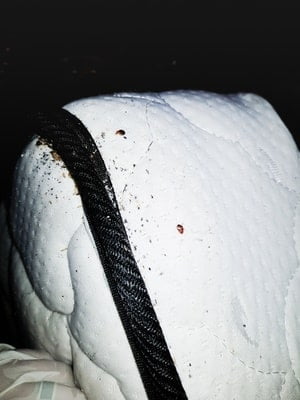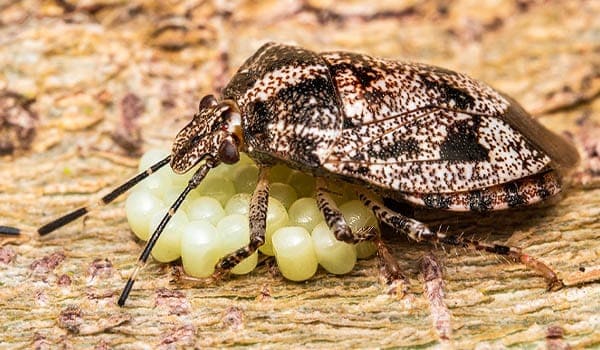Bed bugs grow in number because they find safe and secure places to lay their eggs. They also need somewhere that will have easy access to you, their host, for a regular blood meal.
Bed bugs like to lay their eggs in mattresses and furniture. These places offer safety, darkness, and are close access to their host. They may also lay eggs around cracks in the wall, baseboard, and floorboards. They can’t lay eggs on your skin or hair. Bed bug eggs can be spotted easily as they are white, 1/10 of an inch long, and laid in clusters.
Learning more about their preferred locations, and what their eggs look like, makes them easier to kill. We’ll be covering everything you need to know about bed bugs eggs and where to find them.
Where Do Female Bed Bugs Lay Eggs?
Bed bugs don’t lay their eggs just anywhere. There are locations that they especially prefer. Here, they will live, breed, digest their food, and lay their eggs. These places are called harborages.
Bed bugs select their harborages carefully. Doing so is the difference between living and safely reproducing, and not.
Do You Get Bed Bug Eggs on Mattress?
The mattress is a bed bug’s favorite home. It has everything they could want. The best thing is that it provides the best access possible to their host. A bed bug living in a mattress could have a meal every night if it wanted.
Not only that, but mattresses provide somewhere safe for a bed bug. The underside of a mattress is seldom disturbed. The fewer disturbances, the more eggs they can lay, and the bigger the infestation can become.
Also, bugs are attracted to the smell of people. Your bedding and mattress will smell like you even if you don’t notice that it does. And when you’re in bed at night, they will be drawn to you anyway.
They will try to find a crack or crevice to live in on your mattress. This means that the fabric piping around the mattress’ edges is a favorite hiding place. They could also hide:
- Underneath the corner of the mattress, between the mattress and the bed frame
- In the frame of the bed itself
- Underneath any zips or tags on the mattress
- Underneath any buttons that are a part of the mattress
- Inside the mattress itself, if there are any holes in the fabric exterior
Most infestations begin in the mattress. Female bed bugs will lay eggs all around the mattress until there’s no room left. They will then search out other places around the room to lay more eggs.
Do Bed Bugs Lay Eggs in Furniture?
Furniture offers lots of cracks for them to hide in. Wood joins, the area around the feet and legs of furniture, and internal drawers and sections are good hiding places for bed bug eggs.
Furniture is also rarely disturbed. While you may change your bedding frequently, you rarely move the bed frame. The same applies to bedside tables, wardrobes, and cupboards. Because you don’t move them, you won’t disturb the bed bugs inside. This is good for them.
Here’s some advice on checking old furniture for bed bugs.
Do Bed Bugs Lay Eggs in Clothes?
Bed bugs can lay eggs in clothes. However, they won’t lay eggs in your clothes when you’re wearing them. They don’t like trying to stay on you when you move around.
Instead, they will lay eggs in clothes when they’re not being worn. Clothes offer lots of dark and secure folds for them to hide in. That especially applies to clothes that you hardly ever wear, which are perfect because they’re rarely disturbed.

Clothes are also good for bed bugs because of where you store them. Bed bugs love cupboards, wardrobes, and other furniture. If you have an infestation, it’s likely that they’re already in there. Your clothes may be infested too.
Bed bugs are attracted to the smell of a person’s skin and sweat. Not only that, but bed bugs are comfortable on fabric. While the bed bug’s ancestors lived in caves, today they prefer fabric. Many of their preferred hiding places are fabric surfaces.
On the plus side, bed bugs won’t live in your clothes when you’re wearing them. They don’t like being that close to you all the time.
Here’s some advice on washing clothes exposed to bed bugs.
Do Bed Bugs Lay Eggs on The Carpet?
Bed bugs can lay eggs in the carpet but only very rarely. The carpet is an open area. Bed bugs dislike sunlight, so the uncovered surface of the carpet is far from ideal for them. It’s far more likely to be a carpet beetle. However, there are a few circumstances in which they might choose to:
- If your room has been untidy for a long time, and there are lots of things on the carpet for them to hide under.
- If the corner of the carpet has lifted up, allowing them to get underneath. Or, if there is a hole in the carpet for them to get through.
- If there is a significant gap between the carpet and the baseboard for them to hide in.
Usually, the sunlight would be enough to stop them from laying their eggs there.
Why Do Bed Bugs Lay Their Eggs in These Places?
Bed bugs are most concerned with finding somewhere safe and secure. Doing so minimizes how many bed bugs are squashed or eaten.
This leads to them picking certain places over others. Bed bugs are consistent with harborage selection. Until recently, it was not well understood how or why they would choose certain places.
Researchers published in PLoS One found that it relates to color. They set up an experiment where bed bugs had to select a place to hide, with the only difference between them being their color.
They found that black and red paper harborages are preferred compared to yellow, green, blue, and white harborages. They also found that red or black bed bug traps worked significantly better than white ones. Bed bugs can differentiate between these colors in very low light conditions.
The same researchers found that bed bugs love vertical objects. They try to get close to them if they can when selecting a harborage. This makes them attracted to the feet and legs of your bed.
Why do bed bugs act this way? Their brains aren’t developed enough for these to be active decisions. Rather, they act on instinct. They have evolved to have specific preferences which make successful feeding and mating more likely.
Do Bed Bugs Lay Eggs on Humans?
Bed bugs are parasitic pests. Many pests live on animals, like the fleas on a dog or the lice in a child’s hair. These pests benefit from:
- Being small enough that they can escape from the animal if it notices them
- Being able to transfer from host to host through physical contact
- Being able to spread from place to place when the host travels
- Having a constant food source that they can rely on
Logically, then, you might think that bed bugs lay their eggs on people. But it’s not true
Do Bed Bugs Lay Eggs on Skin?
Bed bugs never lay eggs on people. There are several reasons why. When you think of the pests that do live on people permanently, like fleas or mites, they have something in common. They’re small enough to hide and go unnoticed.
Bed bugs are too big to do that. They’re around the size of an apple seed, and are dark brown. Their size makes them easy to spot if they’re crawling on you, let alone living on you. If you have pale skin, they will show up because of their dark coloration too.

And while we are their preferred hosts, that doesn’t mean they want to be around us constantly. Bed bugs prefer coming to feed for twenty minutes, then hiding again. They feed so much, and become so much bigger, that they’re vulnerable if they hang around.
This has been the case for thousands, perhaps millions of years. Bed bugs evolved from bat bugs, which live on bats in caves. However, bats feed on tiny bugs like bed bugs. They have to get away from their host as soon as they can after feeding.
Bed bugs are attracted to our scent, our warmth, and our carbon dioxide. But this attraction only kicks in when they want to feed. At other times, they have no desire to get close to us.
Do Bed Bugs Lay Eggs in Hair?
Bed bugs can’t lay eggs in human hair. It isn’t the right habitat for them, either to live, feed, or lay eggs. Here’s why:
- Bed bugs are too big to clamber in between the hairs on your scalp.
- Bed bugs don’t have claws like lice, with which they can hold onto a hair.
- Bed bugs don’t want to live on their host permanently; they only want to feed occasionally.
This applies both to the hair on your head, and the hair on the rest of your body. Bed bugs will seek out clear spots with no hair on them to feed. The hair interferes with their movement, so they will look for bald patches rather than hairy patches.
Because they don’t have claws or legs that can easily hang onto us, they are easily brushed away if spotted. Even if they aren’t spotted, they will fall out of your hair when you stand up. This makes staying on you permanently an impossible task.
How to Spot Bed Bug Eggs
Bed bug eggs are one of the many signs of an active infestation. If you want to check whether something is infested, eggs aren’t always the best starting point. Instead, you should look for:
- Active bed bugs scuttling around
- Molted shells and dead bed bugs, neither of which will rot away
- Bed bug feces which leaves dark brown/black ink-like stains
If you want to search for bed bugs eggs, though, here’s how.
Can You See Bed Bug Eggs?
Bed bug eggs are easily big enough to be seen by the naked eye. They are 1/10th of an inch long, which is about the thickness of a quarter. They are longer than they are wide.
However, it is not their size that makes them hard to spot. Bed bugs lay their eggs in hard-to-find locations. They do so on purpose to make them safer and more likely to hatch. That’s why they pick the areas described above.
If you know where to look, they are a little easier to see as they are laid in clusters. Always look in cracks and joins first, whether you’re looking at a mattress, bed frame or another piece of furniture. This is always where they’re most likely to be.
What color are bed bug eggs? They are white or off-white. The color doesn’t vary by species or because of any other factor.
What Do Bed Bug Eggs Feel Like?
Bed bug eggs are solid. You can’t squash them like you can squash a bed bug. You have to try and pierce them with a nail if you want to crush them.
However, it’s difficult to pick up a single bed bug egg. When the egg is laid, it is secured in place with a sticky fluid. This fluid dries hard like glue. Once the egg is secured, it won’t roll away. It’s even difficult to scratch it away.

How Many Eggs Do Bed Bugs Lay?
Unlike other bugs and animals, bed bugs only lay one egg at a time. However, she may lay several eggs during the day. It depends on how much food she has access to.
Bed bug females have developed to maximize the number of eggs she can lay. The female will mate once, but then conserve the male’s sperm for a long time. She will draw on it gradually and can lay eggs for months after mating only once.
Bed bugs need to feed to create and lay eggs. Without a blood meal, the female lacks nutrients. She will lay nothing if she has no host. But she will lay continually if she does.
Bed bug resources often quote that they can lay up to five hundred eggs in their lifetime. However, this is based on one study that produced an incredible outlier. In other studies, and real life, the limit is between 200 and 300. Male bed bugs can’t lay eggs.
How Often Do Bed Bugs Lay Eggs?
A female will lay eggs every day or every other day if she has access to food and a secure location. There are limits on the number of eggs that a bed bug can lay. They are:
- Whether the female has access to food.
- Whether the female can find a new harborage. When she wants to lay eggs, she will venture off to discover somewhere new. If she can’t find anywhere, she won’t lay eggs.
- Whether the female has recently mated. Bed bug females can lay eggs for months after mating just once. But they can’t produce eggs without mating at all.
If all of these boxes are ticked, then the female will continually lay eggs. After two months or so, she will need to mate again to carry on. The cycle will then begin again, where she heads off to find a new harborage. Here’s some information on the lifecycle of bed bugs.
Because bed bugs mate through traumatic insemination, eventually her shell will become too damaged to mate, and she will die. Whatever the case, she will pick a similar place to her existing harborage—either furniture, the mattress, or crack in the wall.


Thank you for the great information. Iam dealing with bed bugs. I’m so tired from dealing with this awful problem. I have sprayed every crack and crevis in my apartment. I am a really clean person and so is my apartment. However my son went camping and put a blanket he had used in my ottomun. I found about six bed bugs around the living room. I killed those and searched for others. But didn’t see any for two weeks. But I sprayed anyway. Apparentley a few made it to my bedroom. I have been dealing with bb now for two weeks. I have bb powder on the feet of the bedframe. Around the room in cracks and all base boards. I also have used spray also. So far for two nights they can’t get on the bed. I vacuum everyday. And vacuum the mattress when I change the sheets. I sure hope they all will die. I can’t take much more if this.
Have they disappeared?
I am having an infestation of some kind. O bed bugs make skin feel taky and sticky? Do bugs or eggs live i seems of clothes? Also, i am finding a number of tiny particles attached to a fine hairlike structure. Are these bugs. When i use a lint roller on my bed where i slept, there are hundreds of these little hairs with a tiny lint like ball attached. I have a few bites but i am not overly itchy. Its the tackyness on my fingers, fingernails and webbing of my hands that bothers me the most, and the prickly feeling of my clothes that appear to have eggs? stored in the seams. It is driving me crazy. What ever is in my clothes survives the washer and dryet, being left out in cold, and being double baged for 3-4 days. Its taking over my life. I am taking medication for cadidid, and i have used cream for scabies. I am washing my self with anti-fungal shampoo and using anti-fungal lotion everyday. I still have these symptoms. Which seem to align to more then one type of infestation. Any ideas?